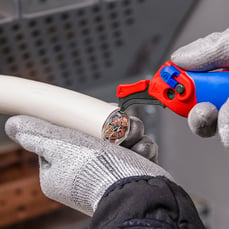The new KNIPEX 16 50 145 stripping knife has been specially developed for professional electricians and offers a perfect combination of functionality and precision. In this post, we answer the most frequently asked questions to help you get the most out of your stripping knife.
You're interested in learning more about multifunctional products for electricians? See here.
1. How do I change the blade on the stripping knife and where is the interchangeable blade located?
Changing the blade on the KNIPEX stripping knife is quick and easy. The replacement blade can be purchased separately as a spare part (item no. 16 50 145 E01). To change the blade, loosen the screw with a screwdriver, press out the bolt and remove the old blade, insert the new blade and bolt and tighten the screw again.
2. How do I position the stripping knife correctly?
Correct positioning is crucial so that you can cut cleanly and precisely. The KNIPEX stripping knife should be aligned so that the guide shoe slides parallel under the cable sheath when cutting lengthways with the ratchet function and when cutting lengthways with a fixed blade. Make sure that the blade hits the cable sheath evenly. For the circumferential cut, simply place the rear cutting edge against the cable sheath and guide it around the cable in a controlled manner. Pay attention to the cutting depth to avoid damaging the conductors under the cable. The markings on the blade provide a guide to the cutting depth.




3. How do I hold the blade correctly when ratcheting and apply the correct pressure to the blade?
For optimum results, hold the cable knife by the handle without applying excessive pressure and place the thumb of your second hand on the thumb rest above the blade to stabilise the blade. The ratchet mechanism does the heavy cutting work, so you only need to provide guidance. The guide shoe prevents the conductors from being cut and damaged.
4. Why is the blade of the stripping knife adjustable?
 During the actual cutting process, even when ratcheting, the blade itself remains in position. When ratcheting, you only move the handle. In general, the blade can be moved to enable different types of cuts: Lengthwise cuts (pull and push) as well as circumferential cuts. This flexibility is crucial, as it not only enables the optimum angle and precise cuts, but also enables the ratchet function. The blade's manoeuvrability means that the blade adapts perfectly to the user's needs so that it can be used efficiently and reliably - whether you are cutting along the cable or around the cable sheath.
During the actual cutting process, even when ratcheting, the blade itself remains in position. When ratcheting, you only move the handle. In general, the blade can be moved to enable different types of cuts: Lengthwise cuts (pull and push) as well as circumferential cuts. This flexibility is crucial, as it not only enables the optimum angle and precise cuts, but also enables the ratchet function. The blade's manoeuvrability means that the blade adapts perfectly to the user's needs so that it can be used efficiently and reliably - whether you are cutting along the cable or around the cable sheath.
5. Why doesn't the stripping knife have a VDE handle?
The stripping knife is designed for working on cables that are not under voltage and therefore does not have VDE-insulated handles. It should only be used for work on non-live cables.
6. Why is there a guide shoe?
The guide shoe protects the inner cable cores. It minimises the risk of damaging the insulation or cables, making work safer for electricians.
7. What are the 4 locking positions and what are they for?
The four locking positions enable better adjustment for cutting and reliable transport. You can adjust the blade to different positions for easier and more controlled work.
8. How do I open the stripping knife?
 The knife has a three-stage integrated locking mechanism, which is released by opening the blue locking latch and then simultaneously pressing the blue slide and the round grey button. The blade can then be carefully gripped by the thumb rest and brought into the desired locking position. To return to the transport position or to set a different locking position, the locking mechanism must also be actuated.
The knife has a three-stage integrated locking mechanism, which is released by opening the blue locking latch and then simultaneously pressing the blue slide and the round grey button. The blade can then be carefully gripped by the thumb rest and brought into the desired locking position. To return to the transport position or to set a different locking position, the locking mechanism must also be actuated.
With the KNIPEX 16 50 145 stripping knife, you have the ideal tool for your stripping work. Thanks to its flexible use, robust design and well thought-out safety functions, this knife is the perfect choice for professional electricians.
Find out more on our product page.





